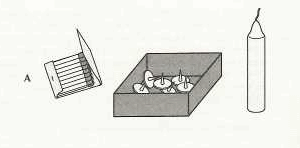The secret of motivation. Part 1. “$” vs. “for fun”. #1 “Candle problem"
We have the resources. Money is an interference. Because it limits our ability, and it limits our dreams.
source (Introduction to a Resource Based Economy)
In this series of posts I’d like to talk about what social science knows and what business does when it comes to motivation.
We will talk about extrinsic and intrinsic motivators, their benefits and disadvantages, biological foundation of motivation and some other stuff.
As far as I can see, the traditional business model is based on the assumption that the more $ rewards one gets, the better the performance he/she shows.
However, let’s take a look at the “Candle problem” developed by Karl Duncker in 1945 [1].
“Candle problem” for fun
a) The real "Candle problem"

(source - Wiki, Public Domain)
So, you have a box of thumbtacks, a candle and some matches. Your task is to mount the candle on a wall and light it in such a way so that the candle wax won’t drip onto the table or floor.
The majority of people try to melt the bottom of the candle and then fix it to the wall.
Doesn’t work. The wax starts to drip onto the table or the candle drops.
However, after a while these people realize that the box with thumbtacks may not only be used as a place for the latter, but also as a platform to place the candle. Eureka!

(source - Wiki, Public Domain)
The problem is based on the cognitive bias called functional fixedness.
is a cognitive bias that limits a person to use an object only in the way it is traditionally used.
(source)
It takes some creativity to accomplish the task. Initially the function of the box is “fixed” to serve as a container. Participants have to use a familiar object for a new purpose (use the box as a platform, not a container). They have to overcome their past experience.
b) "Candle problem" for Dummies
There’s a simplified “Candle problem” which looks like this:

(source - "Case Study #1: Innovation--The Candle Problem", Creative Commons, Attribution 3.0 Unported (CC BY 3.0) )
Now, when the thumbtacks are out of the box, the task is much simpler, right? If the box is empty, then it’s for some purpose. There’s no functional fixedness here anymore. And the people solve the problem much faster [1].
“Candle problem” for $
Sam Glucksberg modified the experiment. Now participants get rewarded with/motivated by $. The faster you solve the task, the more $ you get.
Surprisingly, in case a) (see above) the participants (motivated by $ now) solve the problem much longer than in Duncker’s version of the experiment.
However, in case b) (see above) the participants (motivated by $ now) solve the problem much faster that in Duncker’s version of experiment.
It means that the $ narrows our focus, dulls thinking, blocks creativity and restrict our possibility.
when the correct habit is dominant, a high drive should facilitate problem solving.
… high drive prolongs extinction of the dominant habit (Perin, 1942) and thus retards the correct habit from gaining ascendancy (Kendler & Lachman, 1958).
(source - [2])
By “dominant habit” they mean the initial state of the box in this case (box with thumbtacks or without them).
But when the task doesn’t require creativity, when there’s a simple set of rules and a clear understanding of what you need to do (case b)), the $ enforces people to do the job faster, compared to those not motivated by $ [2].
What’s interesting is that 5-year-old children are “immune” to the functional fixedness effect. It seems that due to lack of past experience (given their young age), they initially can see different ways to solve the problem (we can not only teach our children, but also learn something from them) [3].
Plus, we can increase the performance by giving the participants a written version of the task and underlining relevant parts (like “on the table there is a >candle<, a >box< of >tacks<, and a >book< of >matches<…”), or by providing differentiated linguistic construction (like "box and tacks", rather than "box of tacks" (undifferentiated linguistic construction)) [4, 5].
Conclusion
Extrinsic motivators (reward-and-punishment, or “carrot and sticks” approach) are good when it comes to tasks which are monotonic and could be automated, while intrinsic motivators are great in motivating people to accomplish high-skill tasks. Intrinsic motivation is based around our desire to do things because they matter, they're interesting or part of something important.
I suppose that in the future all the monotonic job will be automated and accomplished exclusively by machines while creative work will be done by people.
Seems like some business organizations have already realized this while others haven’t.
Well, possibly, they will have to find out this the hard way.
What do you think about crypto-powered social media platforms?
Do we really increase or decrease the quality of our posts/demonstrate less/more creativity by giving people a chance to get/motivating them with $?
Thanks for reading.
Feel free to share your thoughts.
PS:
Hope it's not a stupid question, but how can we underline the words on STEMGEEKS?
References
Posted with STEMGeeks
You can use
<u></u>for underlined stuff (I don't think there's a markdown equivalent).Amusingly when I was doing the candle problem in my head before continuing to read I was wondering if the box was strong enough to hold up the candle and if it was okay to destroy the wall with the thumb tacks and then trying to figure out a method of attaching the box to the wall with the candle in it without damaging the wall and then questioning whether it was really absolutely necessary to attach the box with the candle to the wall XD
I don't overthink things at all nope not me
Well, I think I'm starting to understand the money motivation thing a little better now (I can understand the obsession with money seeing as it seems to be needed for everything, otherwise I just find it a real nuisance at best and unnecessary hindrance at worst for that exact reason).
yes, I guess not everything is clear in the "Candle problem" description I provided in the post.
I had similar questions when I tried to solve the problem for the first time.
... if it was okay to destroy the wall with the thumb tacks,... etc.
And I didn't solve it by myself. Only after I saw the solution.
the original problem has been modified by other researches.
just in case, here's the original problem (as per Duncker, K, 1945):
(source)
"You can use
<u></u>for underlined stuff.."tried it.
STEMGEEKS shows the message:
"Disable side-by-side editor
Please remove the following HTML elements from your post:
<u>"it seems that neither STEMGEEKS not any other interface like PeakD actually allows to underline the text.
but anyway, that's not really important.
"I can understand the obsession with money seeing as it seems to be needed for everything, otherwise I just find it a real
nuisance at best and unnecessary hindrance at worst for that exact reason"
nicely said.
What do you think, could we one day get rid of this money interface used to decide how resources should be used,
and create an environment where there's no need for the money, the world where people would manage the Earth's resources
without money and politics. That's what J.Fresco suggests to people with his Venus project.
https://www.thevenusproject.com/
I use peakd to write that comment with that code in it. I used peakd all the time. Apparently
<ins></ins>is meant to work as well but that doesn't do anything on peakd.There's also a possibility that it only works in comments but that seems kinda dumb.
I'm assuming @thevenusproject that's here is that Venus Project but looks like they haven't posted in a while. It's theoretically possible (because most things are theoretically possible) but currency is required to make the type of economies we have work and it seems most people can't fathom any other type of economy or the world working in any other type of way.
In my project I know they use time as some kind of currency and there seem to be governments that manage things at a very high level and they seem to manage to get things done, and because I'm focusing on a specific group of characters I only have a really vague idea of how their world works, but I'm otherwise pretty sure we could get there eventually XD
well, The Venus project Youtube account is active
(Nov 16, 2020)
(Theofilos Chaldezos - Mitigate Pandemics Through a Unified System: A Global Solution)
thank you for your thoughtful comments and support )
!ENGAGE 30
ENGAGEtokens.!ENGAGE 30
ENGAGEtokens.only green candles, please :D
thank you, interesting idea.
I suppose that was a joke, but
actually I'm planning to run this "Candle problem" in the school with children.
You gave a great idea to experiment with the candles of different colours.
Who knows, maybe this will have an impact on the results.
(Candle Color Meanings)
https://www.spiritualmagickal.com/candle-colors-meanings.htm
yes, it was a joke. After I made it, we got handed a lot of RED candles at bitcoinwisdom.io :D
I'm glad it inspired you to experiment with color.
!ENGAGE 30
ENGAGEtokens.